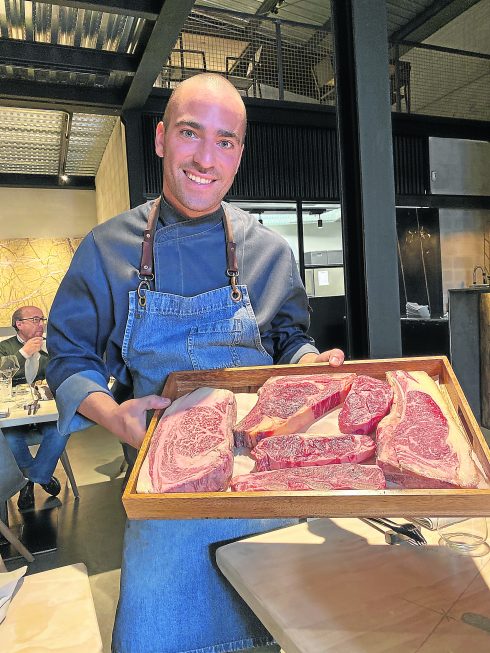WHEN the annual list for the top 100 chefs in the world came out last month, it made for proud reading for Spain.
There were an incredible four Spanish cooks in the global Top 10, while seven made it into the Top 20.
That Madrid’s culinary genius Dabiz Munoz had won for his second year was less surprising for me than the sheer number of lesser known chefs who made the Top100 of the Best Chef poll.

For this year, there are actually 19 chefs spread over 16 amazing Spanish restaurants, easily battering Italy and France into second and third position with 15 and 10 chefs apiece.
Chosen by 150 professionals around the world, including food critics, the Best Chef positioning is later arranged by 200 global chefs, including 100 who don’t make the final list.

It is serious stuff and it is not hard to see how well Spain has progressed since the list first came out in 2017.
Back then, while Catalan Joan Roca was top, Spain had just seven chefs in the list, while France had 23 and Italy 17 entries.
Talk about tables turning in just six years, it will have Les Frogsaleisse choking in their boeuf bourguignon.
And it’s not just this global list to note the remarkable changes, with other prestigious titles, such as Restaurant Magazine’s World’s 50 Best list, which has three Spanish joints in the Top 10 as it has for the last decade.
But take the famous French food bible, the Michelin guide. itself. Today there are 228 restaurants with a Michelin star in Spain (11 with the maximum of three stars), while in 2013 there were just 148 (seven getting the maximum rating).
While this is less stars than in Italy, Japan – and of course France itself – the growth has been extraordinary and shows considerable progress for a country that the French traditionally look down their noses at.
Indeed, when I published my own restaurant book, Dining Secrets of Andalucia, a decade ago, the Michelin guide was taking so little interest in Spain’s largest region that it allegedly only had one inspector here… the same person also in charge of running a rule over next door Extremadura.
I was so amazed at all the excellent places the famous red guide missed on my work trips around the region with the Olive Press or the British nationals, I felt they warranted their own book to promote them. In total, I had 100 references in that book, spread across the eight provinces, of which perhaps only a quarter even got a cursory mention in the Michelin guide.
What I was clearly noticing back then was how much a Spanish gourmet revolution was rapidly spreading around the south.
Nobody had ever questioned that the Basque region or Catalunya had excellent chefs and creativity, much of it assumed to be due to their closeness to France. The resort of San Sebastian had long been a famous place for a food pilgrimage and its record-breaking concentration of Michelin stars is globally recognised.
But what was much less known was how well you could also eat in places like Ronda, Sevilla and Marbella, or Valencia, Toledo and Cadiz. There were literally dozens of creative places popping up each year in the big southern cities, most of it well under the radar.
I felt it was the job of local papers like the Olive Press to champion these new places and to be at the vanguard of the bustling new foodie scenes that were sparking up in little known gems like Vejer de la Frontera, the Aracena region, in Huelva, or the Cabo de Gata park, in Almeria.
What I kept continually noticing was how many local chefs had returned to their hometowns after going off to learn their trade up north and often around the world.

They kept mentioning chefs like Martin Berasategui and Ferran Adria… and not only were they coming back with numerous culinary skills, but they were arriving to find the produce in southern Spain was among the best in Europe. Aside from the legendary vegetables and fruits, including mangoes and avocados, the pork from around Jabugo, the Retinto beef on the Costa de la Luz and the fish from around Barbate, Murcia, Sanlucar and Motril was staggeringly good. And then there was the rice from around Valencia, the saffron from inland and the wild mushrooms from the many varied sierras. They only had to head to their local markets at the crack of dawn to get their share.
But the real key to all of this, I believe, were the foundations put in place throughout the 1980s and 1990s.
This was when Spain’s culinary standing started to come of age, getting past the hedonistic Movida stage of partying and excess that came after the death of Franco.
Famous Five
It was, naturally, up in the north, mostly centred around San Sebastian and Catalunya that the ripples began, founded on the shoulders of five key chefs, the aforementioned Berasategui and Adria, as well as Joan Roca, Pedro Subijana and Juan Mari Arzak.

This famous five of Spanish chefs has had so much influence on the country’s cuisine – and trained hundreds of brilliant chefs – that they deserve to be knighted today.
Each of them bold, creative men, what also marks them out is how much effort they put into training their staff.
One classic example is the success Malaga chef Jose Carlos Garcia has had since serving an internship at Joan Roca’s three Michelin star Celler de Can Roca two decades ago. Celebrating the 10th anniversary at his eponymous, starred restaurant last week, Roca cooked with his former pupil, before expressing his ‘pride’ at how well he has done.
Another talented protege is Benito Gomez at Ronda’s extraordinary two Michelin star Bardal restaurant. When I first met him he was cooking at Ferran Adria’s El Bulli sister restaurant at Finca Benazuza near Sevilla, pulling out a remarkable 25-course tasting menu twice a day. It was the best meal I have ever eaten (aside from the mastery of Dabiz Munoz at Madrid’s Diverxo a few years back) and Benito gives so much respect to the inspiration he got from his teacher Adria who ‘blew away the establishment’.

Adria himself gave a glowing tribute to the new phalanx of chefs ‘doing amazing things’ in Andalucia, six years ago. Speaking to me at an event at Marbella’s Puente Romano hotel, the Catalan revealed how much he loved travelling south since things had improved. “The region really is extraordinary now and just keeps getting better,” he told the Olive Press. “There are at least five or six really amazing restaurants that did not exist here a decade ago and creativity is very much at the fore.”
Subijana (of Akelarre restaurant) is another chef who raved about the rapid improvements around the south of the country when I interviewed him in 2012. An incredibly generous and nurturing man, he didn’t stop stressing the importance of teaching and gives an enormous amount of time to young chefs.
Meanwhile, San Sebastian’s Berasategui, who has a record 12 Michelin stars globally, has sent out dozens of top chefs to cook around Spain. These include Eneko Atxa, whose own restaurant Azurmendi sits in the Top 20 of both the world’s top restaurant lists.

Last, but not least, Juan Mari Arzak, often described as the ‘godfather of Spanish cuisine’ is credited with creating a creative trend in Spanish cuisine which took on a head of steam when he set up the Basque-based Euro-toques network alongside Subijana in 1986.
One final point worthy of note is the importance in the growth of gourmet tourism over the last few decades with the industry predicted to grow by 16% to €1.8 trillion globally by 2027.
The World Food Travel Association estimates that visitors spend approximately 25% of their travel budget on food and drinks and the figure can get as high as 35% in upmarket destinations. With Spain coming second only to Italy with the largest number of culinary tourists (22%) a year in Europe, it has become very big business.
But, as Ferran Adria stressed to me in 2016, chefs around Spain have been brilliant at just getting on with it and focussing on creativity.
“There is a whole world out there past Michelin stars. Chefs need to inspire and create and not worry about awards and what people think. They just need to keep forging away and working hard and they will get there in the end.”
It seems they have finally started to make it.
READ MORE:
- ‘Best chef in the world’ Dabiz Muñoz opens food truck in Marbella on Spain’s Costa del Sol
- Dabiz Muñoz of Madrid’s DiverXo restaurant named ‘Best Chef in the World’ topping list dominated by Spanish talent
- Don’t make him cry: Celebrity chef Dabiz Muñoz claims onions should never be added to Spanish tortilla
Click here to read more Food & Drink News from The Olive Press.








